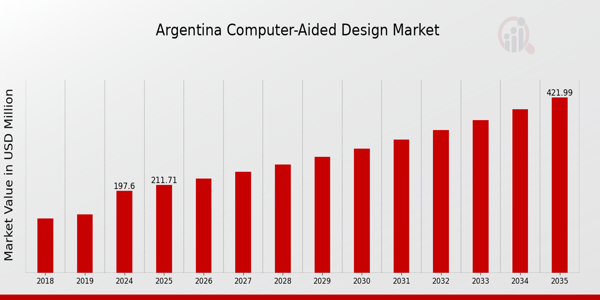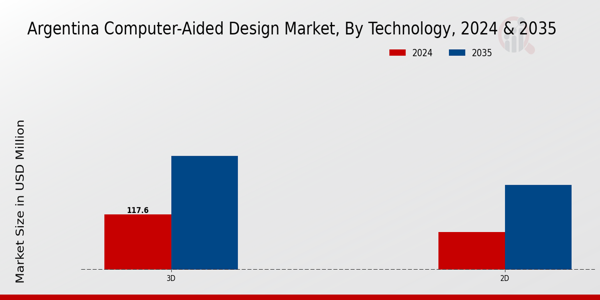Argentina Computer-Aided Design Market Overview
As per MRFR analysis, the Argentina Computer-Aided Design Market Size was estimated at 186.41 (USD Million) in 2023.The Argentina Computer-Aided Design Market is expected to grow from 197.6(USD Million) in 2024 to 422 (USD Million) by 2035. The Argentina Computer-Aided Design Market CAGR (growth rate) is expected to be around 7.141% during the forecast period (2025 - 2035)
Key Argentina Computer-Aided Design Market Trends Highlighted
The market for computer-aided design (CAD) in Argentina is now expanding significantly due to a boom in a number of industries, most notably manufacturing and construction. The Argentinean government has made improving infrastructure development a top priority, which has raised investment in building projects.
Because these programs are essential for architects and engineers to produce accurate drawings and prototypes, this in turn increases demand for CAD tools. The use of CAD has also been impacted by the expanding trend of digital transformation across a number of industries, which is driving businesses toward more accurate and productive design processes.
Additionally, the growing popularity of remote work has increased demand for cloud-based CAD systems, which enable productive remote teamwork. In Argentina, where companies are searching for methods to improve teamwork while reducing operating expenses, this trend is particularly pertinent.
The necessity for environmentally friendly design techniques is becoming more and more important as sectors embrace sustainability, which is why CAD software makers are incorporating tools that make it easier to create sustainable designs.
There are potential to investigate in the Argentine market, especially in the field of education, where CAD courses offered at academic institutions can foster a workforce with advanced design skills.
Additionally, CAD solutions are easily available and reasonably priced, allowing small and medium-sized businesses (SMEs) in Argentina to increase their capabilities without incurring large financial obligations. For those involved in the Argentina CAD market, maintaining a close eye on client demands and technical developments will guarantee ongoing expansion and adjustment as the market changes.

Source: Primary Research, Secondary Research, Market Research Future Database and Analyst Review
Argentina Computer-Aided Design Market Drivers
Rising Demand for Efficient Design Solutions
The Argentina Computer-Aided Design Market is driven by an increasing demand for efficient design solutions across various sectors, including architecture, engineering, and manufacturing. With Argentina's growing construction industry, which saw an increase of 5.1% in 2021, there is a heightened need to enhance productivity and reduce design time.
This demand is being fueled by organizations such as the Argentine Chamber of Construction, which advocates for technological integration within construction firms to improve project turnaround time and maintain competitiveness. By adopting advanced Computer-Aided Design tools, companies can develop innovative designs more effectively, thus attracting more clients and increasing their market share.
Furthermore, Argentina's government has been supporting digital transformation initiatives that encourage businesses to invest in modern design technologies, thereby further driving the growth of the Computer-Aided Design market in the region.
Support from Government Policies
Argentina's government has initiated various policies that favor technology adoption and innovation in various sectors, positively impacting the Argentina Computer-Aided Design Market. Notably, the 'Digital Economy Law' aims to promote the use of digital technologies among small and medium-sized enterprises (SMEs).
A report from the Ministry of Productive Development emphasizes that SMEs in Argentina contribute to 70% of employment. They are encouraged to adopt Computer-Aided Design solutions to improve their processes, thereby increasing efficiency. As these SMEs enhance their design capabilities, they open up new markets and opportunities, securing their position in a competitive landscape.
Growth of the Manufacturing Sector
The growth of the manufacturing sector in Argentina significantly contributes to the expansion of the Argentina Computer-Aided Design Market. In recent years, the manufacturing industry has seen advances due to modernization efforts, with reports indicating a 3.2% growth in the sector in 2021.
Major manufacturers have recognized that utilizing Computer-Aided Design systems enhances precision, reduces prototyping costs, and expedites the product development cycle.
Organizations such as the Argentine Industrial Union have also stressed the importance of incorporating cutting-edge design technologies to fulfill global demand. This transition not only strengthens domestic production but also bolsters Argentina's position as a competitive manufacturing hub in South America.
Increase in the Education and Training Sector
The Argentina Computer-Aided Design Market benefits from a rise in education and training initiatives focused on digital design technologies. Universities and technical institutes across Argentina have expanded their curricula to include Computer-Aided Design programs, responding to the increasing job market demand for skilled individuals in this area.
A report from the National Institute of Statistics and Censuses reveals that enrollment in engineering and technology-related courses has increased by 12% in the last three years.
Institutions such as the University of Buenos Aires and the National University of La Plata are among key players fostering this educational growth, ensuring that the workforce is well-equipped to leverage Computer-Aided Design tools, ultimately facilitating market expansion.
Argentina Computer-Aided Design Market Segment Insights
Computer-Aided Design Market Technology Insights
The Technology segment of the Argentina Computer-Aided Design Market has been experiencing remarkable transformation, driven by advancements in software and hardware capabilities. This segment encompasses a spectrum of tools and technologies utilized for various design applications, significantly enhancing efficiency and productivity across multiple industries.
The demand for 2D and 3D design technologies remains strong as organizations increasingly rely on visual representation and modeling to communicate concepts effectively.
The growing need for precision in design, coupled with the necessity for rapid prototyping and product development, solidifies the relevance of 3D design tools, which dominate the marketplace by enabling comprehensive visualization of projects before actual production.
In Argentina, the market is progressively adopting sophisticated technologies like parametric and direct modeling, which allow designers to make swift adjustments to their designs, ultimately reducing turnaround times and costs. The government's focus on fostering innovation and technology adoption is further propelling the sector, particularly amid ongoing digital transformations.
Industries ranging from architecture and engineering to manufacturing and entertainment are leveraging Computer-Aided Design technologies to enhance their design capabilities, streamline workflows, and gain a competitive advantage.
The integration of Artificial Intelligence and machine learning within these design tools is expected to pave new avenues for automation, thus creating significant opportunities for growth. The segmentation in this market sees a significant emphasis on 2D design as a foundational tool, widely used for tasks such as technical drawings, schematics, and layout designs.
Its role is pivotal in industries such as construction and electronics, where precise visual representation is crucial. Meanwhile, 3D design technology is gaining traction due to its capacity to generate intricate models that foster a deeper understanding of structural and functional designs.
As these 3D solutions continue to evolve with enhanced rendering techniques and simulation capabilities, they represent a significant portion of the market, catering to the sophisticated needs of various sectors.
This bifurcation in the market underscores the fact that while 2D design remains essential, the progressive shift towards 3D technologies is indicative of an overall trend towards immersive and interactive design processes in Argentina’s burgeoning software landscape.
As the Argentina Computer-Aided Design Market evolves, the integration of cloud-based solutions and collaborative platforms is expected to rejuvenate design workflows and foster real-time collaboration among teams, further broadening the scope of technological advancement in this sector.
The resilience of the Technology segment, coupled with the continuous demand for innovative design solutions, illustrates the critical role it plays in driving the Argentina Computer-Aided Design Market forward.

Source: Primary Research, Secondary Research, Market Research Future Database and Analyst Review
Computer-Aided Design Market Component Insights
The Argentina Computer-Aided Design Market is marked by a diversified Component segment, primarily encompassing Software and Services that play a pivotal role in supporting design capabilities across various industries. Software solutions are essential for enhancing productivity and precision in design processes, helping organizations in Argentina streamline their workflow and reduce time-to-market.
As many sectors, including architecture, engineering, and manufacturing, increasingly adopt digital solutions, the demand for advanced Software continues to rise, contributing significantly to market growth.
Meanwhile, Services related to implementation, training, and ongoing support are crucial in ensuring the effective use of CAD tools, further driving user adoption and satisfaction. These components are fundamental to the overall success of the Argentina Computer-Aided Design Market, as they enable businesses to harness innovative design techniques while addressing the region's specific needs.
In light of Argentina's focus on technological advancement and high-quality infrastructure development, the Component segment is also witnessing growth opportunities through collaborations and partnerships aimed at integrating emerging technologies, such as artificial intelligence and cloud computing, into CAD systems.
Overall, the emphasis on enhancing design efficiencies bolsters the significance of both Software and Services within this vital market landscape.
Computer-Aided Design Market Development Model Insights
The Argentina Computer-Aided Design Market has shown a significant focus on Development Model, comprising major components like Cloud and On-Premises solutions. Cloud-based design platforms are gaining traction in Argentina due to rising flexibility, scalability, and collaborative features that allow users to work remotely, aligning with the country's increasing digital transformation efforts.
On-Premises solutions continue to hold their ground significantly, as many industries, particularly manufacturing and architecture, favor them for enhanced control over data security and compliance with local regulations. The demand for these distinct modes of deployment reflects an evolving landscape where businesses strive to optimize efficiency while leveraging advanced tools in their design processes.
As Argentina's economy embraces technological advancements, the segmentation of the Argentina Computer-Aided Design Market will likely reveal more opportunities, meeting the diverse needs of different industry sectors.
With the growing focus on digitalization and the increasing complexity of design tasks, understanding the unique advantages of both Cloud and On-Premises solutions will become more critical for organizations aiming to thrive in a competitive environment.
Computer-Aided Design Market Application Insights
The Argentina Computer-Aided Design Market is anticipated to see considerable growth, influenced heavily by the diverse applications of design technologies across various industries.
Among these applications, 3D Printing stands out as increasingly significant, allowing for rapid prototyping and innovative manufacturing solutions, thus fostering advancements in sectors such as aerospace and automotive.
Surface Modelling continues to dominate due to its essential role in creating visually appealing and technically accurate designs, which are crucial for consumer products and architecture.
Reverse Engineering offers critical capabilities for restoration and enhancement of pre-existing designs, playing a vital role in Research and Development across various sectors. Drafting Detailing has also grown in importance, as it provides the meticulous accuracy required for construction and engineering projects.
Lastly, the Assembly segment is key for streamlining processes in manufacturing, ensuring that components fit together seamlessly. Each of these applications contributes to the overall Argentina Computer-Aided Design Market data, highlighting its multifaceted nature and potential for innovation within high-growth sectors.
Together, these applications showcase the adaptability and expanding footprint of the Argentina Computer-Aided Design Market, positioning it favorably against global trends driven by technological advancements and evolving consumer needs.
Computer-Aided Design Market End-use Vehicle Insights
The End-use Vehicle segment of the Argentina Computer-Aided Design Market is a vital component of the broader industry, reflecting significant advancements across diverse sectors such as Electrical, Electronics, and Automotive.
The Automotive industry, driven by growing consumer demand and innovation, plays a crucial role in this segment as manufacturers increasingly adopt Computer-Aided Design tools to enhance vehicle design and safety. Similarly, the Civil and Construction sectors leverage these technologies to streamline project management and optimize resource allocation, contributing to increased operational efficiency.
The Energy sector also benefits from Computer-Aided Design, utilizing it for effective infrastructure planning and management. The ongoing industrialization in Argentina has spurred demand for advanced Industrial Equipment, emphasizing the necessity for precise design solutions.
Other areas such as Media and Entertainment see significant innovation through enhanced graphic and animation capabilities. As these segments continue to evolve, they collectively underscore the importance of advanced design technologies in driving the Argentina Computer-Aided Design Market forward.
The adaptability of these sectors highlights their pivotal role in economic growth and technological advancement within the region.
Argentina Computer-Aided Design Market Key Players and Competitive Insights
The Argentina Computer-Aided Design Market has been witnessing significant growth, driven by advancements in technology and an increasing demand for digital design solutions across various sectors including manufacturing, architecture, and engineering.Competitive dynamics in this market are influenced by a blend of local and international players, each vying for market share by offering innovative products and services tailored to the unique needs of Argentine businesses.
Factors such as affordability, user-friendly interfaces, and integration with existing workflows play critical roles in shaping customer preferences. The competitive landscape is marked by a variety of strategies, including partnerships, collaborations, and robust marketing campaigns aimed at capturing the attention of potential users in the region.
PTC has established a formidable presence in the Argentina Computer-Aided Design Market by focusing on delivering quality solutions that cater to industries needing advanced design capabilities. One of the key strengths of PTC is its pioneering technologies in product lifecycle management and its robust CAD solutions, which are tailored to enhance collaboration and streamline design processes.
The company’s innovative approach has positioned it as a leader in the market, appealing significantly to organizations looking to improve operational efficiency. PTC benefits from its comprehensive support network and training programs, which empower local users to maximize the potential of their software while ensuring that industries in Argentina remain competitive on a global scale.
On the other hand, Autodesk is a prominent player within the Argentina Computer-Aided Design Market, known for its suite of design software solutions that cater to various sectors, including architecture, engineering, and entertainment.
The company’s flagship products, which include software for 3D design, modeling, simulation, and collaboration, have received positive feedback for their ease of use and integration capabilities. Autodesk's strengths lie in its commitment to innovation and customer support, making it an attractive choice among Argentine firms.
The company has engaged in strategic mergers and acquisitions, enhancing its product portfolio and securing a stronger foothold in the market. This strategic growth ensures that Autodesk not only meets the existing demands of the local market but also anticipates future trends in design technology, maintaining its competitive edge in the region.
Key Companies in the Argentina Computer-Aided Design Market Include
- PTC
- Autodesk
- SolidWorks
- Trimble
- ZWCAD
- Alibre
- Bentley Systems
- Esri
- Dassault Systemes
- Nemetschek
- Siemens
- Graphisoft
- CNC Software
Argentina Computer-Aided Design Market Developments
In recent months, the Computer-Aided Design (CAD) market in Argentina has seen notable advancements. Notably, PTC has reported increased adoption of its Creo software across various industries, leading to enhanced design capabilities for local manufacturers. Autodesk has also made strides with its cloud-based solutions, facilitating remote collaboration among design teams.
In July 2023, SolidWorks expanded its educational programs in Argentina, fostering a new generation of engineers skilled in advanced design tools. On the acquisition front, Siemens announced in October 2023 its acquisition of a local CAD start-up, bolstering its existing portfolio and enhancing its competitive edge in the region.
Additionally, ZWCAD has gained traction among small and medium enterprises due to its cost-effective solutions, reflecting a growing trend towards affordable CAD options.
As of September 2023, the Argentine government has also committed to investing in technology infrastructure, aligning with the global shift towards digitization in manufacturing. Overall, the CAD market in Argentina is witnessing a mix of innovation and strategic growth, greatly influenced by both local enterprises and international players.
Argentina Computer-Aided Design Market Segmentation Insights
Computer-Aided Design Market Technology Outlook
Computer-Aided Design Market Component Outlook
Computer-Aided Design Market Development Model Outlook
Computer-Aided Design Market Application Outlook
- 3D Printing
- Surface Modelling
- Reverse Engineering
- Drafting Detailing
- Assembly
- Others
Computer-Aided Design Market End-use Vehicle Outlook
- Electrical
- Electronics
- Automotive
- Civil
- Construction
- Energy
- Materials
- Industrial Equipment
- Media
- Entertainment
- Others
| Report Attribute/Metric Source: |
Details |
| MARKET SIZE 2023 |
186.41(USD Million) |
| MARKET SIZE 2024 |
197.6(USD Million) |
| MARKET SIZE 2035 |
422.0(USD Million) |
| COMPOUND ANNUAL GROWTH RATE (CAGR) |
7.141% (2025 - 2035) |
| REPORT COVERAGE |
Revenue Forecast, Competitive Landscape, Growth Factors, and Trends |
| BASE YEAR |
2024 |
| MARKET FORECAST PERIOD |
2025 - 2035 |
| HISTORICAL DATA |
2019 - 2024 |
| MARKET FORECAST UNITS |
USD Million |
| KEY COMPANIES PROFILED |
PTC, Autodesk, SolidWorks, Trimble, ZWCAD, Alibre, Bentley Systems, MSI, Esri, Dassault Systemes, Nemetschek, Siemens, Graphisoft, Bimobject, CNC Software |
| SEGMENTS COVERED |
Technology, Component, Development Model, Application, End Use Vehicle |
| KEY MARKET OPPORTUNITIES |
Growing demand for architectural design, Expansion of manufacturing sector, Increased adoption of 3D modeling, Rise in government infrastructure projects, Advancements in cloud-based CAD solutions |
| KEY MARKET DYNAMICS |
growing demand for 3D modeling, increasing adoption of cloud solutions, rise in architectural projects, growing influence of automation, need for cost-effective solutions |
| COUNTRIES COVERED |
Argentina |
Frequently Asked Questions (FAQ):
The Argentina Computer-Aided Design Market is expected to be valued at 197.6 million USD in 2024.
By 2035, the Argentina Computer-Aided Design Market is projected to reach a value of 422.0 million USD.
The expected CAGR for the Argentina Computer-Aided Design Market from 2025 to 2035 is 7.141%.
The market is divided into 2D and 3D technology segments, with 2D valued at 80.0 million USD and 3D at 117.6 million USD in 2024.
By 2035, the 2D segment is expected to reach 180.0 million USD, while the 3D segment is projected to grow to 242.0 million USD.
Major players in the market include PTC, Autodesk, SolidWorks, Trimble, ZWCAD, Alibre, Bentley Systems, and more.
The market presents opportunities driven by increasing demand for advanced design solutions and technological innovations.
Challenges in the market may include competition from emerging technologies and the need for continuous innovation.
Key applications include architectural design, engineering simulations, product design, and manufacturing processes.
Current global trends and conflicts are influencing market dynamics, affecting supply chains and customer demand.
















